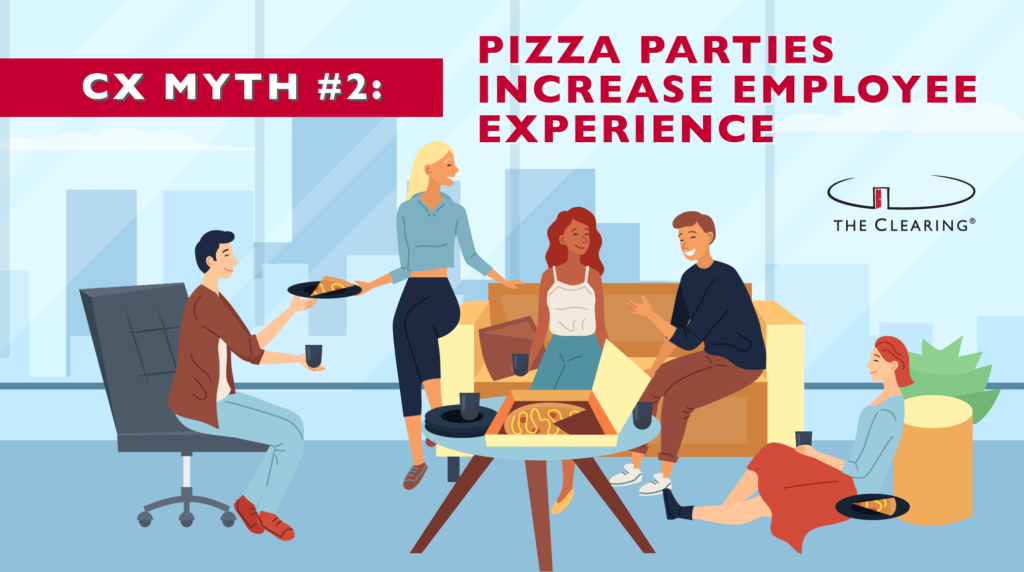I’ve recently been rewatching The Office. If you’re a fan like me, you’re familiar with self-proclaimed “World’s Best Boss” Michael Scott and his frequent and desperate attempts to win the hearts and minds of his employees. Often Michael tempts staff with free food and social events: Pizza by Alfredo and “Movie Mondays.” While Michael means well, his gestures may satisfy his employees in the moment, but not the next day, when he encounters the same disengaged workforce.
While the Dunder Mifflin office is fiction, the reason The Office is popular is because it resonates with so many of us. Practices like free lunches, casual Fridays, or in today’s virtual environment, Zoom happy hours and employee care packages, are not the sole kinds of investments that ensure our employees feel valued and part of an inclusive organization. Employers are not seeing meaningful ROI from these efforts alone, so why spend time and money on small gestures that don’t lead to our desired outcomes?
Offering free lunch is an example of what Harvard Business Review (HBR) calls an adrenaline shot: a short-term, employee engagement effort designed to temporarily boost employee satisfaction. Adrenaline shots feel nice in the moment but provide no lasting impact on the overall, long-term employee experience (EX). According to HBR, “when organizations make real gains…they’re going beyond what engagement scores are telling them to do in the moment… creating a place where people want, not just need, to work each day.” Only when organizations go beyond short-term satisfaction boosters can they reap the rewards of positive EX.
What Does Positive EX Mean for Your Organization?
Greater Financial Returns
According to IBM’s Smarter Workforce Institute’s 2018 report, “The Financial Impact of a Positive Employee Experience,” “Organizations that score in the top 25% on employee experience report nearly three times the return on assets….” and “… double the return on sales compared to organizations in the bottom quartile.” A recent Towers Perrin study found that companies “with the highest percentage of engaged employees collectively increased operating income 19% and earnings per share 28% year to year. Those companies with the lowest percentage of engaged employees showed year-to-year declines of 33% in operating income and 11% in earnings per share.”
Higher Employee Retention Rates
Employee experience also has a direct impact on retaining employees. Gallup’s 2016 Meta-Analysis on The Relationship Between Engagement at Work and Organizational Outcomes found that of the 230 organizations studied, companies scoring high in employee engagement have between 24%-59% less turnover, depending on the industry, compared to those with low employee engagement scores. Multiple studies show that the total cost of losing an employee can range from tens of thousands of dollars to 1.5-2 times their annual salary. No matter which sector you work in, one way to easily increase efficiency is to retain top talent. Investing in employee experience keeps top talent around, engaged, and saves money in the long run.
Higher Customer Satisfaction and Goal Achievement
Finally, beyond financial ROI, Gartner found that “Organizations whose employees are largely satisfied with their experience are 48% more likely to meet organizational customer satisfaction goals, 89% more likely to meet organizational innovation goals, and 56% more likely to meet organizational reputation goals.” Moreover, “employees who are largely satisfied with their experience are 52% more likely to report high discretionary effort and 69% more likely to be a high performer.”
Myth Busted… Companies Should Invest More in EX than Pizza Parties
In order to move the needle forward on employee engagement and benefit from the investment, organizations need to commit to their employees’ long-term experience. Employee experience is a customer experience; from the technology they use to the workspace they use every day. Understanding their journey as a whole is important. It’s time to move beyond focusing only on one-time interactions and free pizza.






 The Clearing’s Employee Experience
Improvement model, adapted from Itam
& Ghosh, 2020, focuses on three objectives:
The Clearing’s Employee Experience
Improvement model, adapted from Itam
& Ghosh, 2020, focuses on three objectives: 














